Colonisation and the Policies for Indigenous People
VerifiedAdded on 2022/08/22
|7
|1590
|20
AI Summary
Contribute Materials
Your contribution can guide someone’s learning journey. Share your
documents today.
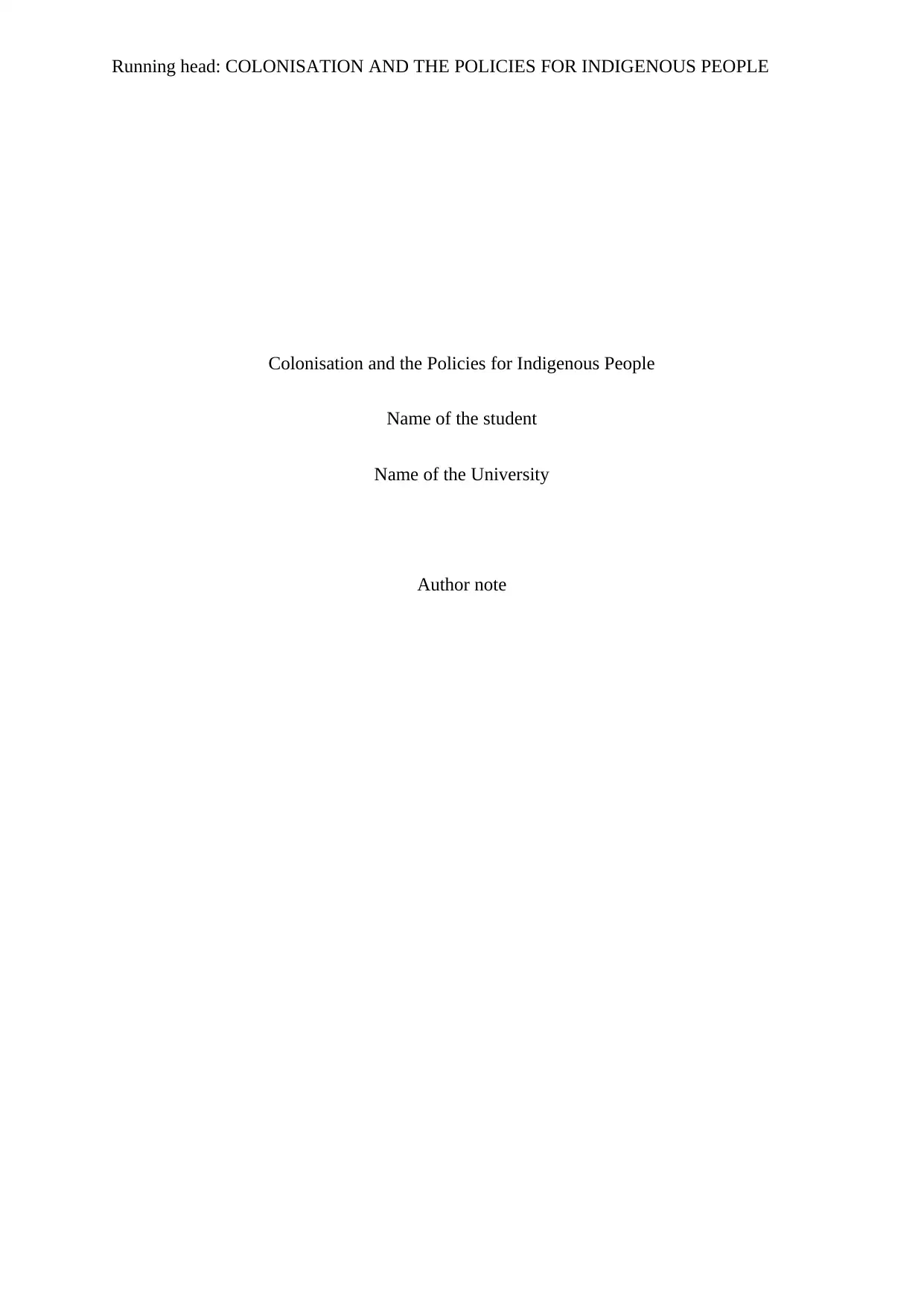
Running head: COLONISATION AND THE POLICIES FOR INDIGENOUS PEOPLE
Colonisation and the Policies for Indigenous People
Name of the student
Name of the University
Author note
Colonisation and the Policies for Indigenous People
Name of the student
Name of the University
Author note
Secure Best Marks with AI Grader
Need help grading? Try our AI Grader for instant feedback on your assignments.
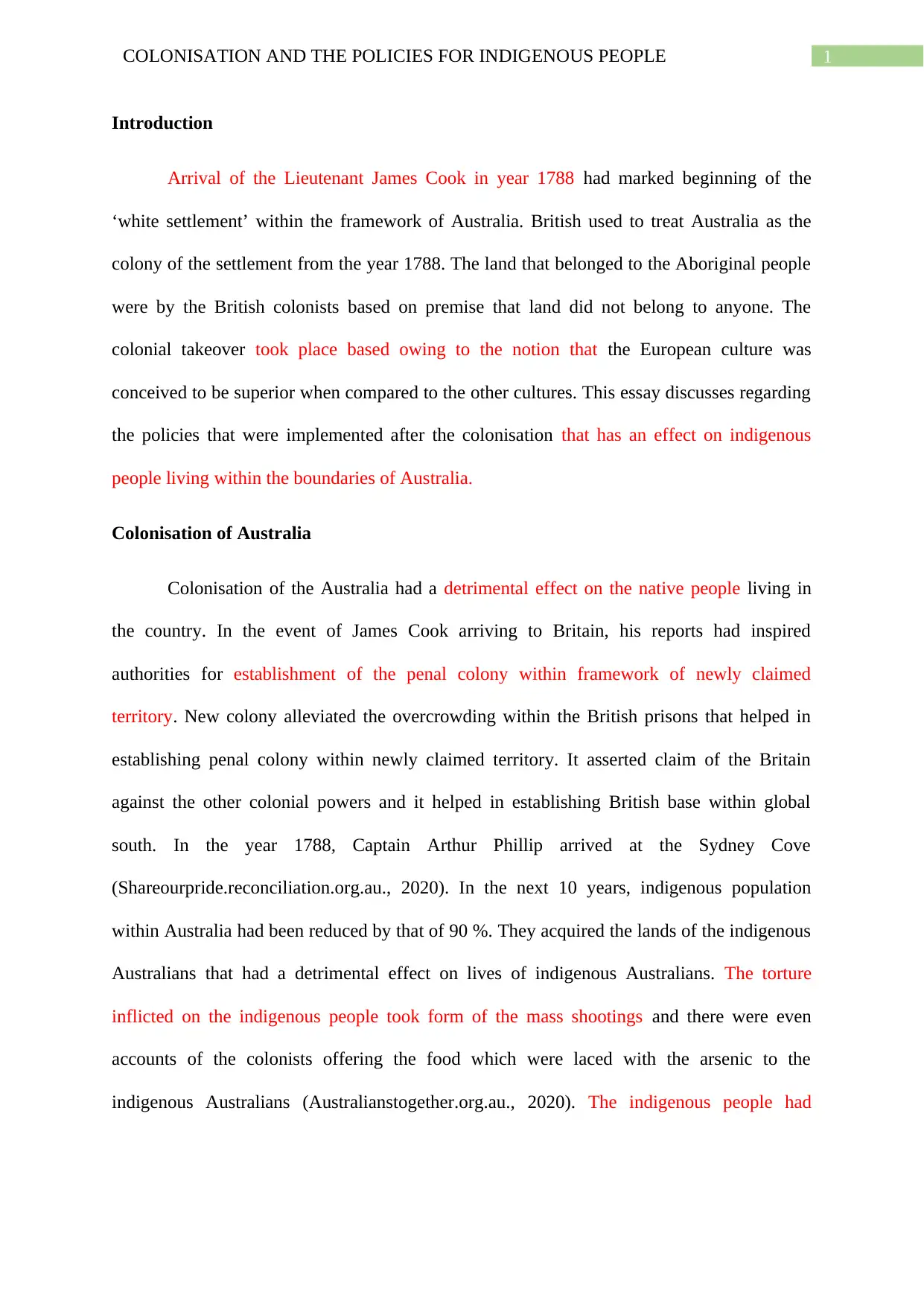
1COLONISATION AND THE POLICIES FOR INDIGENOUS PEOPLE
Introduction
Arrival of the Lieutenant James Cook in year 1788 had marked beginning of the
‘white settlement’ within the framework of Australia. British used to treat Australia as the
colony of the settlement from the year 1788. The land that belonged to the Aboriginal people
were by the British colonists based on premise that land did not belong to anyone. The
colonial takeover took place based owing to the notion that the European culture was
conceived to be superior when compared to the other cultures. This essay discusses regarding
the policies that were implemented after the colonisation that has an effect on indigenous
people living within the boundaries of Australia.
Colonisation of Australia
Colonisation of the Australia had a detrimental effect on the native people living in
the country. In the event of James Cook arriving to Britain, his reports had inspired
authorities for establishment of the penal colony within framework of newly claimed
territory. New colony alleviated the overcrowding within the British prisons that helped in
establishing penal colony within newly claimed territory. It asserted claim of the Britain
against the other colonial powers and it helped in establishing British base within global
south. In the year 1788, Captain Arthur Phillip arrived at the Sydney Cove
(Shareourpride.reconciliation.org.au., 2020). In the next 10 years, indigenous population
within Australia had been reduced by that of 90 %. They acquired the lands of the indigenous
Australians that had a detrimental effect on lives of indigenous Australians. The torture
inflicted on the indigenous people took form of the mass shootings and there were even
accounts of the colonists offering the food which were laced with the arsenic to the
indigenous Australians (Australianstogether.org.au., 2020). The indigenous people had
Introduction
Arrival of the Lieutenant James Cook in year 1788 had marked beginning of the
‘white settlement’ within the framework of Australia. British used to treat Australia as the
colony of the settlement from the year 1788. The land that belonged to the Aboriginal people
were by the British colonists based on premise that land did not belong to anyone. The
colonial takeover took place based owing to the notion that the European culture was
conceived to be superior when compared to the other cultures. This essay discusses regarding
the policies that were implemented after the colonisation that has an effect on indigenous
people living within the boundaries of Australia.
Colonisation of Australia
Colonisation of the Australia had a detrimental effect on the native people living in
the country. In the event of James Cook arriving to Britain, his reports had inspired
authorities for establishment of the penal colony within framework of newly claimed
territory. New colony alleviated the overcrowding within the British prisons that helped in
establishing penal colony within newly claimed territory. It asserted claim of the Britain
against the other colonial powers and it helped in establishing British base within global
south. In the year 1788, Captain Arthur Phillip arrived at the Sydney Cove
(Shareourpride.reconciliation.org.au., 2020). In the next 10 years, indigenous population
within Australia had been reduced by that of 90 %. They acquired the lands of the indigenous
Australians that had a detrimental effect on lives of indigenous Australians. The torture
inflicted on the indigenous people took form of the mass shootings and there were even
accounts of the colonists offering the food which were laced with the arsenic to the
indigenous Australians (Australianstogether.org.au., 2020). The indigenous people had
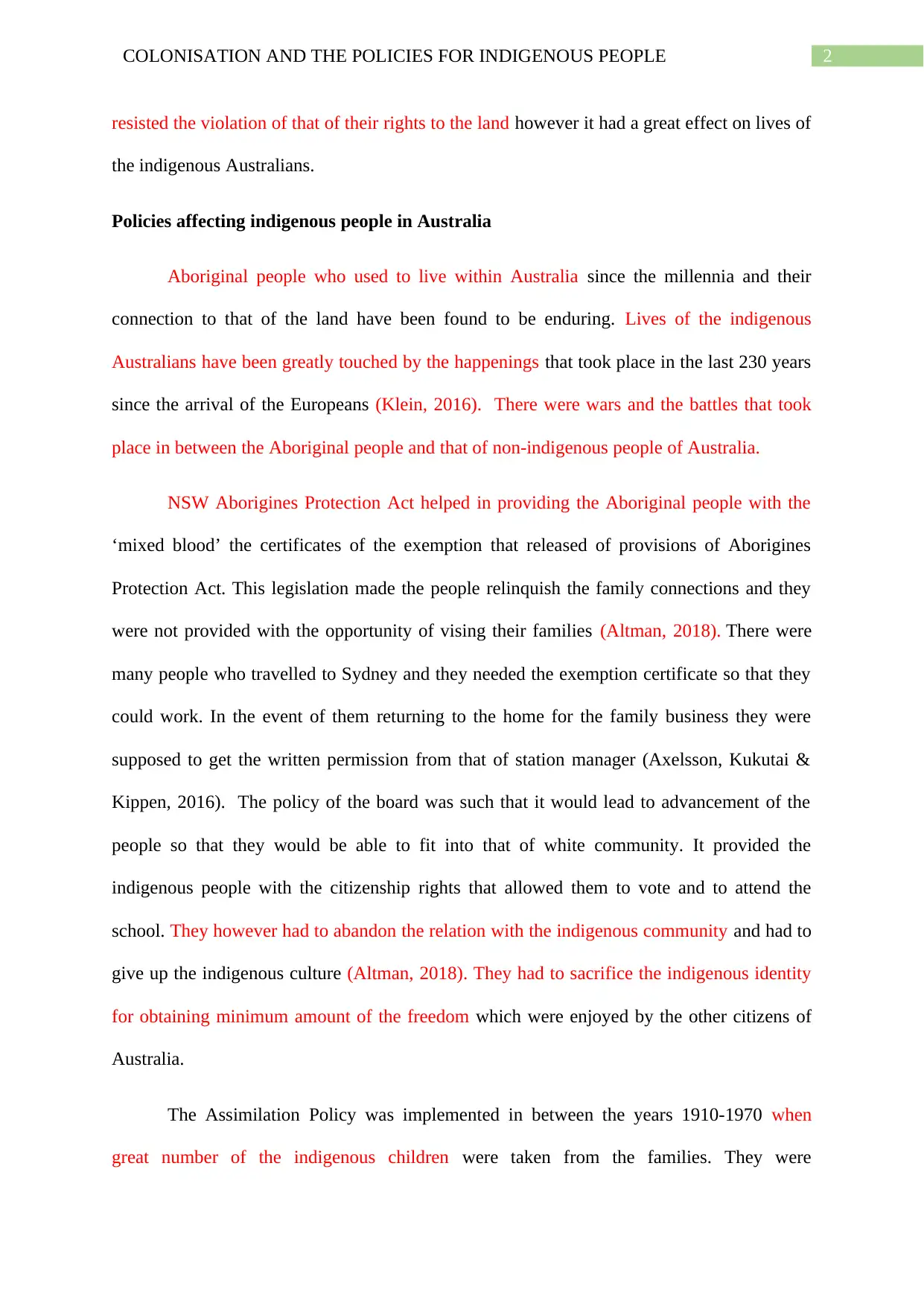
2COLONISATION AND THE POLICIES FOR INDIGENOUS PEOPLE
resisted the violation of that of their rights to the land however it had a great effect on lives of
the indigenous Australians.
Policies affecting indigenous people in Australia
Aboriginal people who used to live within Australia since the millennia and their
connection to that of the land have been found to be enduring. Lives of the indigenous
Australians have been greatly touched by the happenings that took place in the last 230 years
since the arrival of the Europeans (Klein, 2016). There were wars and the battles that took
place in between the Aboriginal people and that of non-indigenous people of Australia.
NSW Aborigines Protection Act helped in providing the Aboriginal people with the
‘mixed blood’ the certificates of the exemption that released of provisions of Aborigines
Protection Act. This legislation made the people relinquish the family connections and they
were not provided with the opportunity of vising their families (Altman, 2018). There were
many people who travelled to Sydney and they needed the exemption certificate so that they
could work. In the event of them returning to the home for the family business they were
supposed to get the written permission from that of station manager (Axelsson, Kukutai &
Kippen, 2016). The policy of the board was such that it would lead to advancement of the
people so that they would be able to fit into that of white community. It provided the
indigenous people with the citizenship rights that allowed them to vote and to attend the
school. They however had to abandon the relation with the indigenous community and had to
give up the indigenous culture (Altman, 2018). They had to sacrifice the indigenous identity
for obtaining minimum amount of the freedom which were enjoyed by the other citizens of
Australia.
The Assimilation Policy was implemented in between the years 1910-1970 when
great number of the indigenous children were taken from the families. They were
resisted the violation of that of their rights to the land however it had a great effect on lives of
the indigenous Australians.
Policies affecting indigenous people in Australia
Aboriginal people who used to live within Australia since the millennia and their
connection to that of the land have been found to be enduring. Lives of the indigenous
Australians have been greatly touched by the happenings that took place in the last 230 years
since the arrival of the Europeans (Klein, 2016). There were wars and the battles that took
place in between the Aboriginal people and that of non-indigenous people of Australia.
NSW Aborigines Protection Act helped in providing the Aboriginal people with the
‘mixed blood’ the certificates of the exemption that released of provisions of Aborigines
Protection Act. This legislation made the people relinquish the family connections and they
were not provided with the opportunity of vising their families (Altman, 2018). There were
many people who travelled to Sydney and they needed the exemption certificate so that they
could work. In the event of them returning to the home for the family business they were
supposed to get the written permission from that of station manager (Axelsson, Kukutai &
Kippen, 2016). The policy of the board was such that it would lead to advancement of the
people so that they would be able to fit into that of white community. It provided the
indigenous people with the citizenship rights that allowed them to vote and to attend the
school. They however had to abandon the relation with the indigenous community and had to
give up the indigenous culture (Altman, 2018). They had to sacrifice the indigenous identity
for obtaining minimum amount of the freedom which were enjoyed by the other citizens of
Australia.
The Assimilation Policy was implemented in between the years 1910-1970 when
great number of the indigenous children were taken from the families. They were
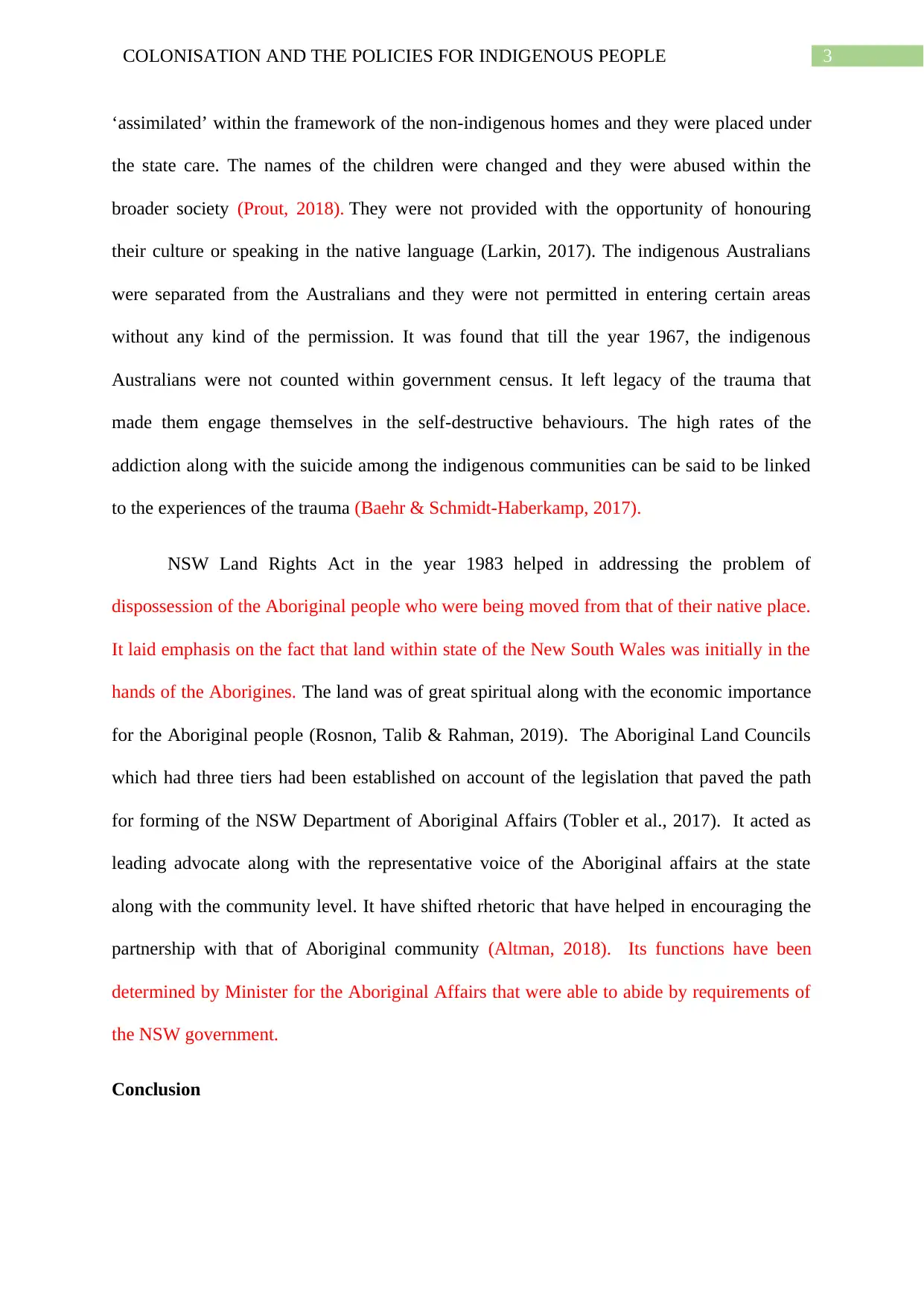
3COLONISATION AND THE POLICIES FOR INDIGENOUS PEOPLE
‘assimilated’ within the framework of the non-indigenous homes and they were placed under
the state care. The names of the children were changed and they were abused within the
broader society (Prout, 2018). They were not provided with the opportunity of honouring
their culture or speaking in the native language (Larkin, 2017). The indigenous Australians
were separated from the Australians and they were not permitted in entering certain areas
without any kind of the permission. It was found that till the year 1967, the indigenous
Australians were not counted within government census. It left legacy of the trauma that
made them engage themselves in the self-destructive behaviours. The high rates of the
addiction along with the suicide among the indigenous communities can be said to be linked
to the experiences of the trauma (Baehr & Schmidt-Haberkamp, 2017).
NSW Land Rights Act in the year 1983 helped in addressing the problem of
dispossession of the Aboriginal people who were being moved from that of their native place.
It laid emphasis on the fact that land within state of the New South Wales was initially in the
hands of the Aborigines. The land was of great spiritual along with the economic importance
for the Aboriginal people (Rosnon, Talib & Rahman, 2019). The Aboriginal Land Councils
which had three tiers had been established on account of the legislation that paved the path
for forming of the NSW Department of Aboriginal Affairs (Tobler et al., 2017). It acted as
leading advocate along with the representative voice of the Aboriginal affairs at the state
along with the community level. It have shifted rhetoric that have helped in encouraging the
partnership with that of Aboriginal community (Altman, 2018). Its functions have been
determined by Minister for the Aboriginal Affairs that were able to abide by requirements of
the NSW government.
Conclusion
‘assimilated’ within the framework of the non-indigenous homes and they were placed under
the state care. The names of the children were changed and they were abused within the
broader society (Prout, 2018). They were not provided with the opportunity of honouring
their culture or speaking in the native language (Larkin, 2017). The indigenous Australians
were separated from the Australians and they were not permitted in entering certain areas
without any kind of the permission. It was found that till the year 1967, the indigenous
Australians were not counted within government census. It left legacy of the trauma that
made them engage themselves in the self-destructive behaviours. The high rates of the
addiction along with the suicide among the indigenous communities can be said to be linked
to the experiences of the trauma (Baehr & Schmidt-Haberkamp, 2017).
NSW Land Rights Act in the year 1983 helped in addressing the problem of
dispossession of the Aboriginal people who were being moved from that of their native place.
It laid emphasis on the fact that land within state of the New South Wales was initially in the
hands of the Aborigines. The land was of great spiritual along with the economic importance
for the Aboriginal people (Rosnon, Talib & Rahman, 2019). The Aboriginal Land Councils
which had three tiers had been established on account of the legislation that paved the path
for forming of the NSW Department of Aboriginal Affairs (Tobler et al., 2017). It acted as
leading advocate along with the representative voice of the Aboriginal affairs at the state
along with the community level. It have shifted rhetoric that have helped in encouraging the
partnership with that of Aboriginal community (Altman, 2018). Its functions have been
determined by Minister for the Aboriginal Affairs that were able to abide by requirements of
the NSW government.
Conclusion
Secure Best Marks with AI Grader
Need help grading? Try our AI Grader for instant feedback on your assignments.
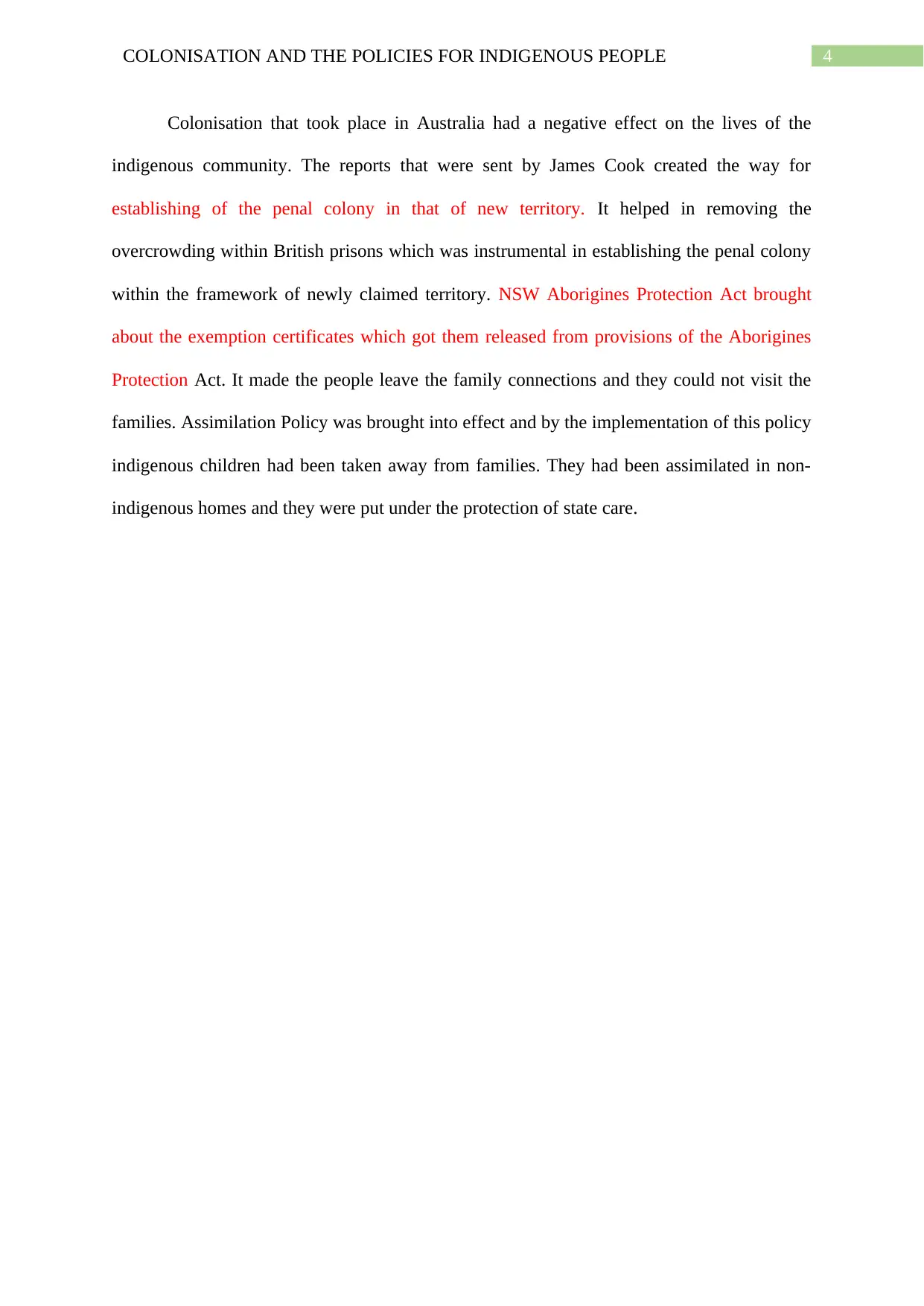
4COLONISATION AND THE POLICIES FOR INDIGENOUS PEOPLE
Colonisation that took place in Australia had a negative effect on the lives of the
indigenous community. The reports that were sent by James Cook created the way for
establishing of the penal colony in that of new territory. It helped in removing the
overcrowding within British prisons which was instrumental in establishing the penal colony
within the framework of newly claimed territory. NSW Aborigines Protection Act brought
about the exemption certificates which got them released from provisions of the Aborigines
Protection Act. It made the people leave the family connections and they could not visit the
families. Assimilation Policy was brought into effect and by the implementation of this policy
indigenous children had been taken away from families. They had been assimilated in non-
indigenous homes and they were put under the protection of state care.
Colonisation that took place in Australia had a negative effect on the lives of the
indigenous community. The reports that were sent by James Cook created the way for
establishing of the penal colony in that of new territory. It helped in removing the
overcrowding within British prisons which was instrumental in establishing the penal colony
within the framework of newly claimed territory. NSW Aborigines Protection Act brought
about the exemption certificates which got them released from provisions of the Aborigines
Protection Act. It made the people leave the family connections and they could not visit the
families. Assimilation Policy was brought into effect and by the implementation of this policy
indigenous children had been taken away from families. They had been assimilated in non-
indigenous homes and they were put under the protection of state care.
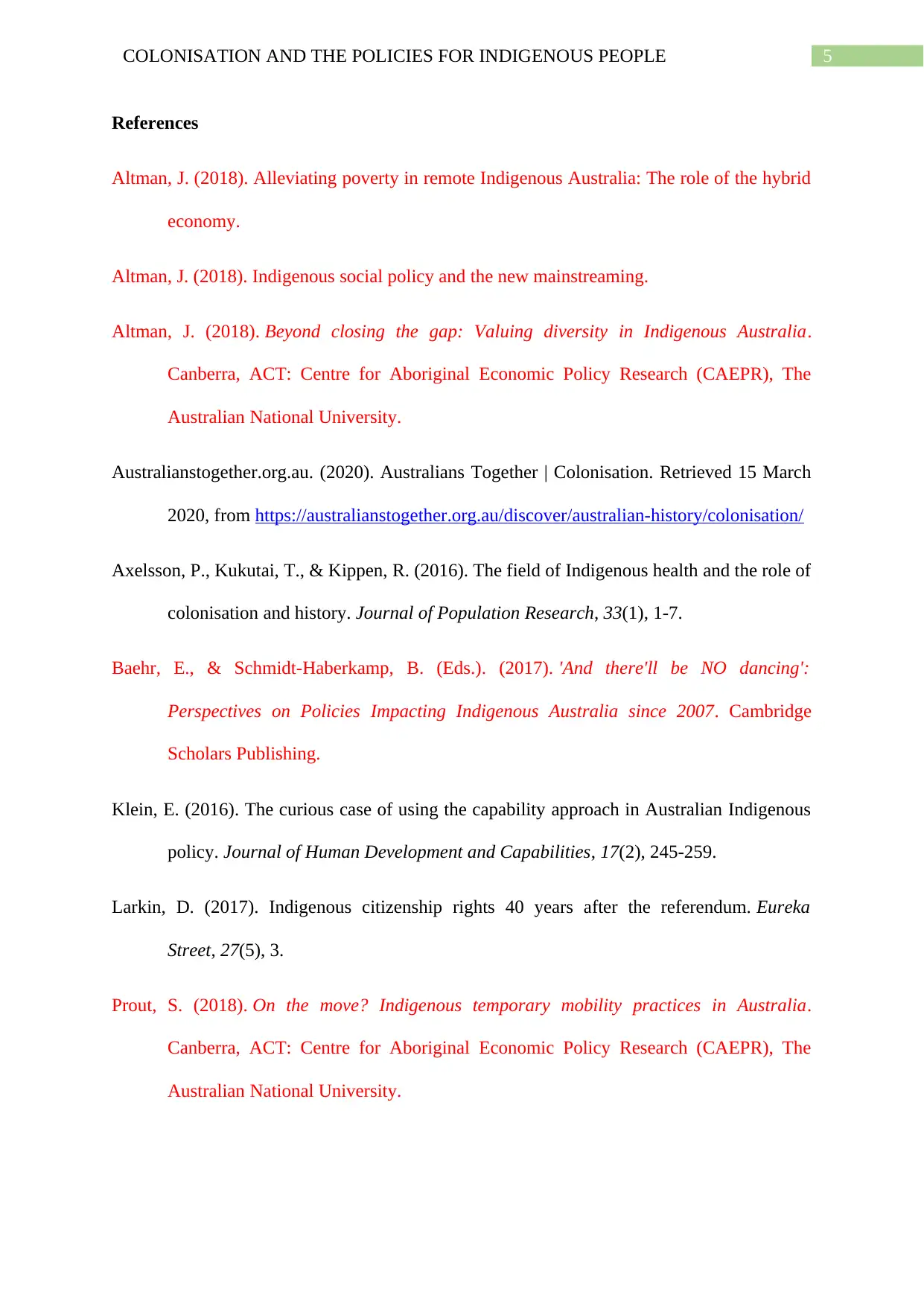
5COLONISATION AND THE POLICIES FOR INDIGENOUS PEOPLE
References
Altman, J. (2018). Alleviating poverty in remote Indigenous Australia: The role of the hybrid
economy.
Altman, J. (2018). Indigenous social policy and the new mainstreaming.
Altman, J. (2018). Beyond closing the gap: Valuing diversity in Indigenous Australia.
Canberra, ACT: Centre for Aboriginal Economic Policy Research (CAEPR), The
Australian National University.
Australianstogether.org.au. (2020). Australians Together | Colonisation. Retrieved 15 March
2020, from https://australianstogether.org.au/discover/australian-history/colonisation/
Axelsson, P., Kukutai, T., & Kippen, R. (2016). The field of Indigenous health and the role of
colonisation and history. Journal of Population Research, 33(1), 1-7.
Baehr, E., & Schmidt-Haberkamp, B. (Eds.). (2017). 'And there'll be NO dancing':
Perspectives on Policies Impacting Indigenous Australia since 2007. Cambridge
Scholars Publishing.
Klein, E. (2016). The curious case of using the capability approach in Australian Indigenous
policy. Journal of Human Development and Capabilities, 17(2), 245-259.
Larkin, D. (2017). Indigenous citizenship rights 40 years after the referendum. Eureka
Street, 27(5), 3.
Prout, S. (2018). On the move? Indigenous temporary mobility practices in Australia.
Canberra, ACT: Centre for Aboriginal Economic Policy Research (CAEPR), The
Australian National University.
References
Altman, J. (2018). Alleviating poverty in remote Indigenous Australia: The role of the hybrid
economy.
Altman, J. (2018). Indigenous social policy and the new mainstreaming.
Altman, J. (2018). Beyond closing the gap: Valuing diversity in Indigenous Australia.
Canberra, ACT: Centre for Aboriginal Economic Policy Research (CAEPR), The
Australian National University.
Australianstogether.org.au. (2020). Australians Together | Colonisation. Retrieved 15 March
2020, from https://australianstogether.org.au/discover/australian-history/colonisation/
Axelsson, P., Kukutai, T., & Kippen, R. (2016). The field of Indigenous health and the role of
colonisation and history. Journal of Population Research, 33(1), 1-7.
Baehr, E., & Schmidt-Haberkamp, B. (Eds.). (2017). 'And there'll be NO dancing':
Perspectives on Policies Impacting Indigenous Australia since 2007. Cambridge
Scholars Publishing.
Klein, E. (2016). The curious case of using the capability approach in Australian Indigenous
policy. Journal of Human Development and Capabilities, 17(2), 245-259.
Larkin, D. (2017). Indigenous citizenship rights 40 years after the referendum. Eureka
Street, 27(5), 3.
Prout, S. (2018). On the move? Indigenous temporary mobility practices in Australia.
Canberra, ACT: Centre for Aboriginal Economic Policy Research (CAEPR), The
Australian National University.
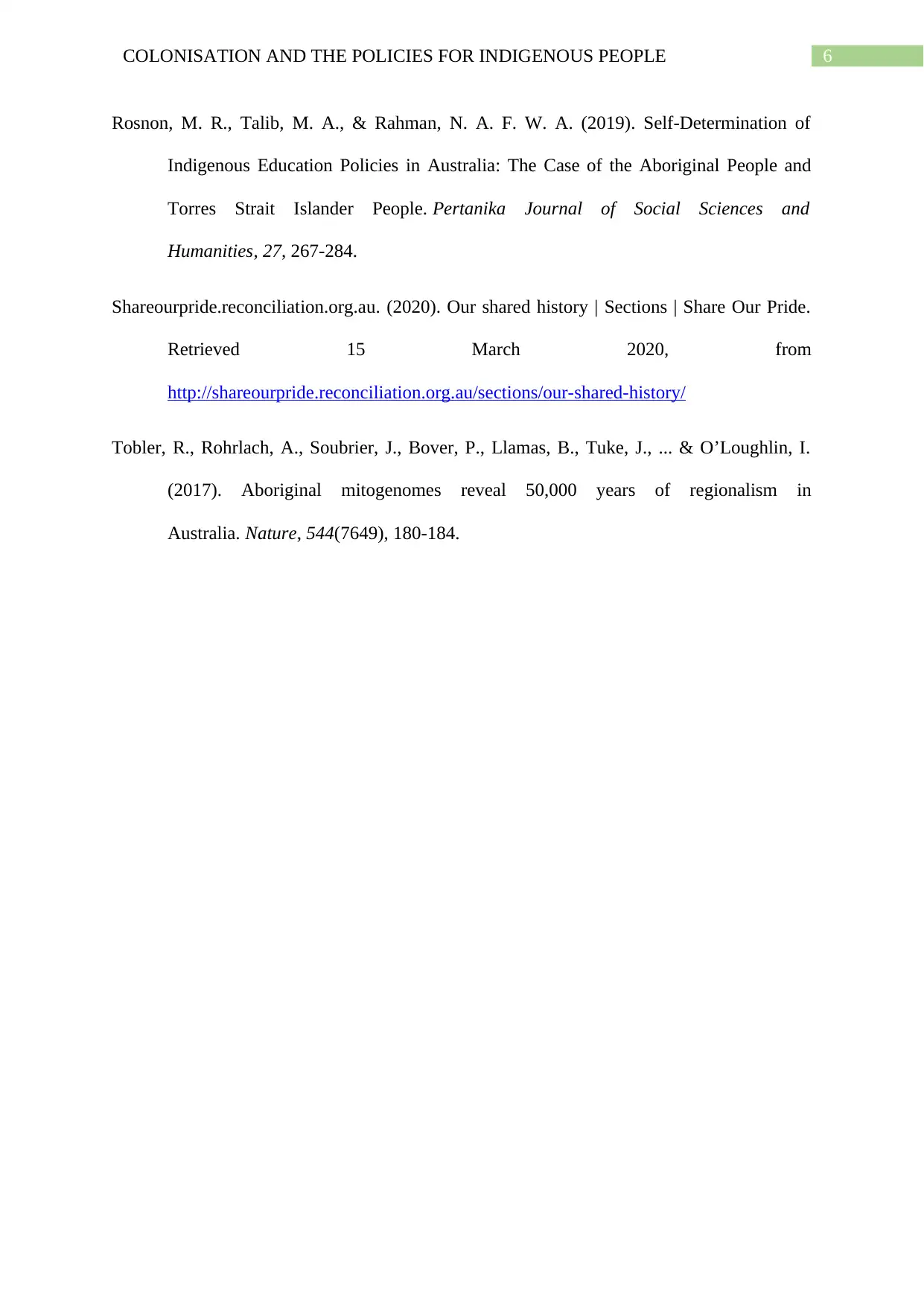
6COLONISATION AND THE POLICIES FOR INDIGENOUS PEOPLE
Rosnon, M. R., Talib, M. A., & Rahman, N. A. F. W. A. (2019). Self-Determination of
Indigenous Education Policies in Australia: The Case of the Aboriginal People and
Torres Strait Islander People. Pertanika Journal of Social Sciences and
Humanities, 27, 267-284.
Shareourpride.reconciliation.org.au. (2020). Our shared history | Sections | Share Our Pride.
Retrieved 15 March 2020, from
http://shareourpride.reconciliation.org.au/sections/our-shared-history/
Tobler, R., Rohrlach, A., Soubrier, J., Bover, P., Llamas, B., Tuke, J., ... & O’Loughlin, I.
(2017). Aboriginal mitogenomes reveal 50,000 years of regionalism in
Australia. Nature, 544(7649), 180-184.
Rosnon, M. R., Talib, M. A., & Rahman, N. A. F. W. A. (2019). Self-Determination of
Indigenous Education Policies in Australia: The Case of the Aboriginal People and
Torres Strait Islander People. Pertanika Journal of Social Sciences and
Humanities, 27, 267-284.
Shareourpride.reconciliation.org.au. (2020). Our shared history | Sections | Share Our Pride.
Retrieved 15 March 2020, from
http://shareourpride.reconciliation.org.au/sections/our-shared-history/
Tobler, R., Rohrlach, A., Soubrier, J., Bover, P., Llamas, B., Tuke, J., ... & O’Loughlin, I.
(2017). Aboriginal mitogenomes reveal 50,000 years of regionalism in
Australia. Nature, 544(7649), 180-184.
1 out of 7
Related Documents
Your All-in-One AI-Powered Toolkit for Academic Success.
+13062052269
info@desklib.com
Available 24*7 on WhatsApp / Email
![[object Object]](/_next/static/media/star-bottom.7253800d.svg)
Unlock your academic potential
© 2024 | Zucol Services PVT LTD | All rights reserved.





